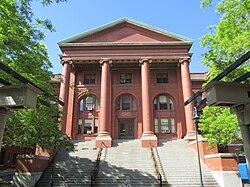East Cambridge Historic District
Historic districts in Middlesex County, MassachusettsHistoric districts on the National Register of Historic Places in MassachusettsNRHP infobox with nocatNational Register of Historic Places in Cambridge, Massachusetts

The East Cambridge Historic District encompasses the historic center of East Cambridge, Massachusetts. It includes the major buildings that were built to house county services for Middlesex County beginning in the 1810s, and a cluster of largely vernacular Greek Revival worker housing located west of the county complex on Otis, Thorndike, Spring, and Sciarappa Streets. The district was listed on the National Register of Historic Places in 1983.
Excerpt from the Wikipedia article East Cambridge Historic District (License: CC BY-SA 3.0, Authors, Images).East Cambridge Historic District
Thorndike Street, Cambridge
Geographical coordinates (GPS) Address Nearby Places Show on map
Geographical coordinates (GPS)
| Latitude | Longitude |
|---|---|
| N 42.37 ° | E -71.080833333333 ° |
Address
Thorndike Street 69
02141 Cambridge
Massachusetts, United States
Open on Google Maps










